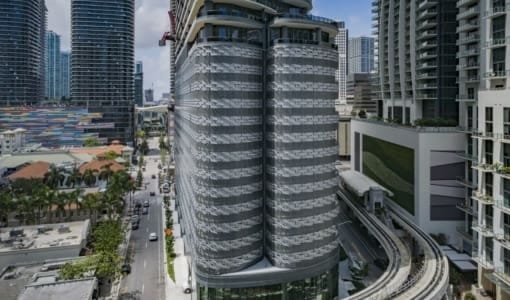Aluminum: Qualities & Applications in Architecture
ALUMINUM — A TWENTIETH CENTURY MATERIAL
A century ago, aluminum was considered a precious metal, more precious than gold or silver. Only a very small amount of the metal had ever been isolated. Aluminum was so rare and hard to come by that Napoleon III treated his most honored dinner guests to forks and spoons made from this metal. Second-rate guests had to struggle through their meal using mere gold or silver cutlery.
Today virtually every new building uses aluminum. Curtainwall extrusions, window framing mullions, storefront supports, spandrel panels, siding and roofing panels, louvers and many other common architectural products are made from this versatile material.
A Brief History of Aluminum
In 1884 the United States, considering materials to cap off the Washington monument, made a fanfare out of a small cast aluminum pinnacle placed at the top of the monument. At the time, this was the single largest casting of aluminum ever made. It weighed in at 100 ounces.
In 1886 a young American metallurgist, Charles Martin Hall, discovered that metallic aluminum could be produced by dissolving alumina (aluminum oxide ore) in molten cryolite. An electrical current was applied to the solution to draw the oxygen out. In the same year a Frenchman, Paul T. Heroult, discovered the identical process. When both men applied for patents, they discovered each other. The process is known today as the Hall-Heroult process, signifying their joint discovery.
Detail of polished aluminum plate in Mexico
PHOTO © A. ZAHNER COMPANYPolished aluminum sculpture fabricated by Zahner for Jan Hendrix
PHOTO © A. ZAHNER COMPANYArchitectural Aluminum
Aluminum is very reactive, far from noble. It immediately forms a layer of oxide approximately 0.1 µm in thickness when exposed to air. This amorphous oxide layer offers corrosion protection to the metal under most circumstances. However, the color this oxide layer develops, particularly when combined with various pollutants from the environment, is not always pleasing. Depending on the surface finish, blotchiness, dark stains, and fuzzy deposits can develop. A maintenance program that periodically removes deposits from the surface can reduce these occurrences.
If the aluminum surface is well drained and kept free of deposits from other metals, it will develop an even gray-white color. The surface will still retain a metallic appearance dulled slightly from the oxide growth on the surface.
Finishes on Aluminum
Nearly all uses of aluminum require some degree of additional cost through surface finish. Aluminum will oxidize if left unfinished, becoming dull and prone to dirt and scratches. Options including anodizing, polishing, coating, or patinating, each with benefits and cautions.
Mirror-polish on aluminum (or near-mirror polish) can be achieved for both a protective and visually intriguing effect. Applying a high-polish on aluminum surface has the added advantage of protecting the metal from corrosion. Highly polished aluminum will provide a very smooth and non-porous surface it will drain and resist deposits from collecting. When left to weather, these surfaces will perform well if used where they are naturally washed or when they are maintained by a periodic scrubbing to remove the particles that do collect on its surface.
Anodized aluminum used on exteriors will have a satin texture, and is an effective method for protection from light handling. Because the aluminum substrate is porous, anodization offers an option to fill these pores with metallic dyes to achieve a variety of colors, all-the-while retaining the distinctive metallic feature of aluminum.
Blackened aluminum will exhibit a course surface on the metal. This is a less common means of imparting color to aluminum. The blackening agent produces a mottled flat black patina on its surface. It may be possible to develop additional tones including dull gray and dark reddish-black tones on the metal through chemical patina. These processes combine aluminum’s reactive nature with its stable oxide growth, and are somewhat difficult to control.
Different alloys of aluminum can be coated onto the surface of aluminum sheet and plate to develop specific properties. Known as alclad, this process coats one alloy of aluminum with another, usually a higher purity aluminum alloy. The higher-purity alloy protects the stronger, less-pure alloying material from atmospheric attack. In this manner, you can use a higher-strength alloy aluminum with poor corrosion resistance. The pure sheet provides excellent barrier coating and a decent galvanic protection.
When the proper pretreatment techniques are used, painted aluminum surfaces offer durable and long-term color solutions to the designer. Aluminum will receive paint finishes readily after it has gone through pretreatment. Baked-on finishes and urethanes are excellent coatings for exterior aluminum.
*Please note that we do not offer supply-only sheets of aluminum, but we are happy to custom fabricate based upon your project’s needs. We selectively partner with vendors offering the highest quality materials available in many sizes and thicknesses. Please contact us for details.


















 PHOTO ©️ Parrish Ruiz de Velasco (parrch.com)
PHOTO ©️ Parrish Ruiz de Velasco (parrch.com)



 © Fedora Hat Photography
© Fedora Hat Photography Photo by Andre Sigur | ARKO
Photo by Andre Sigur | ARKO





 Ɱ, Creative Commons Attribution-Share Alike 4.0 International license, edited.
Ɱ, Creative Commons Attribution-Share Alike 4.0 International license, edited.

